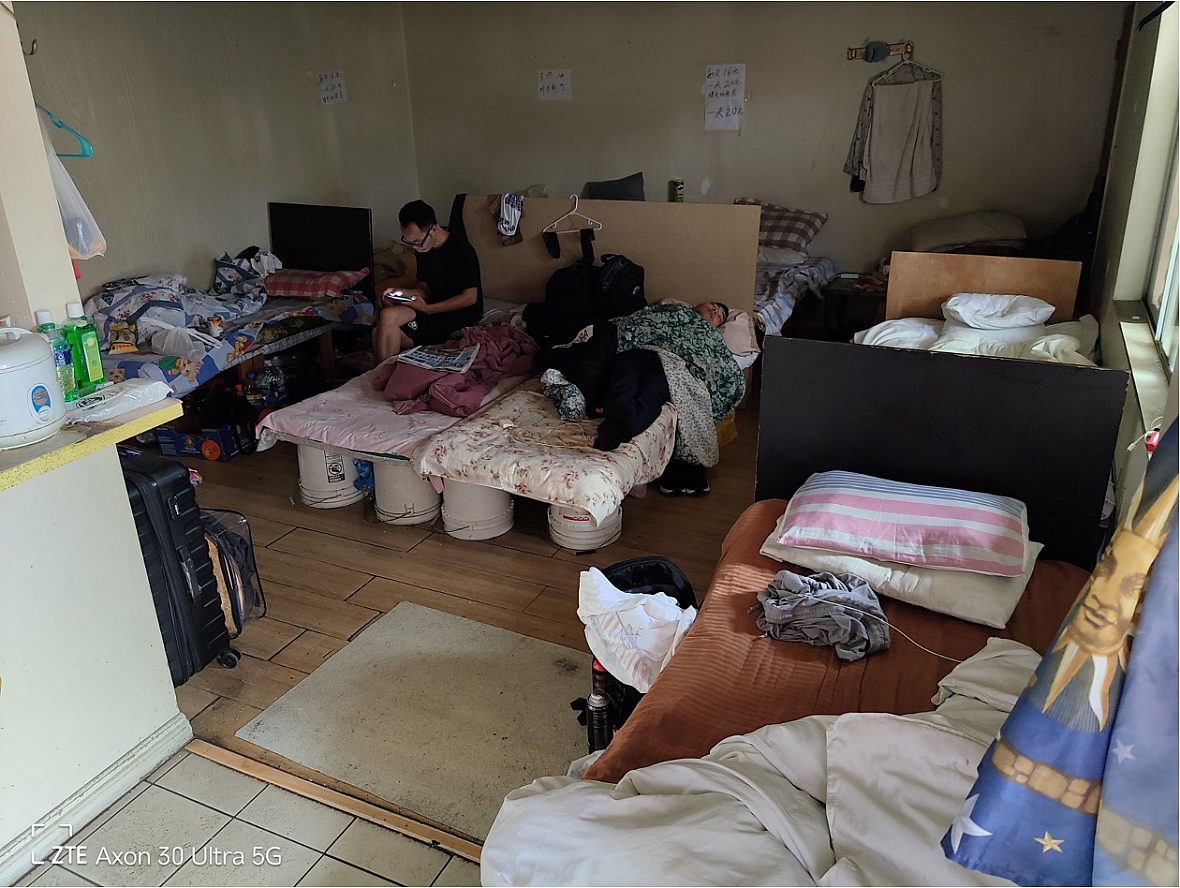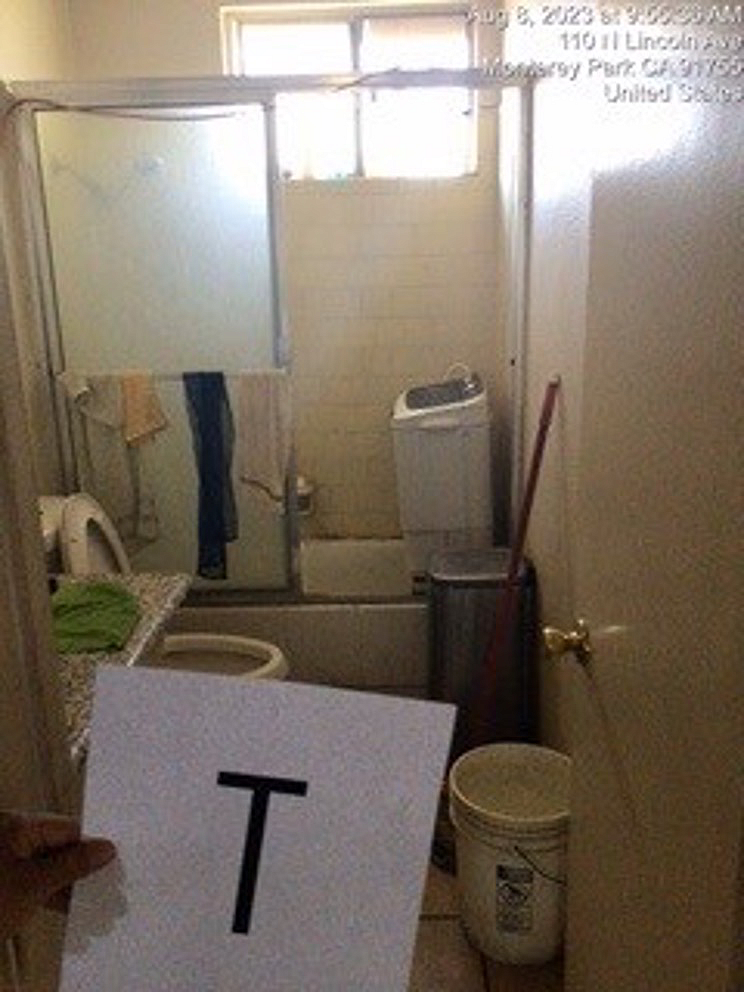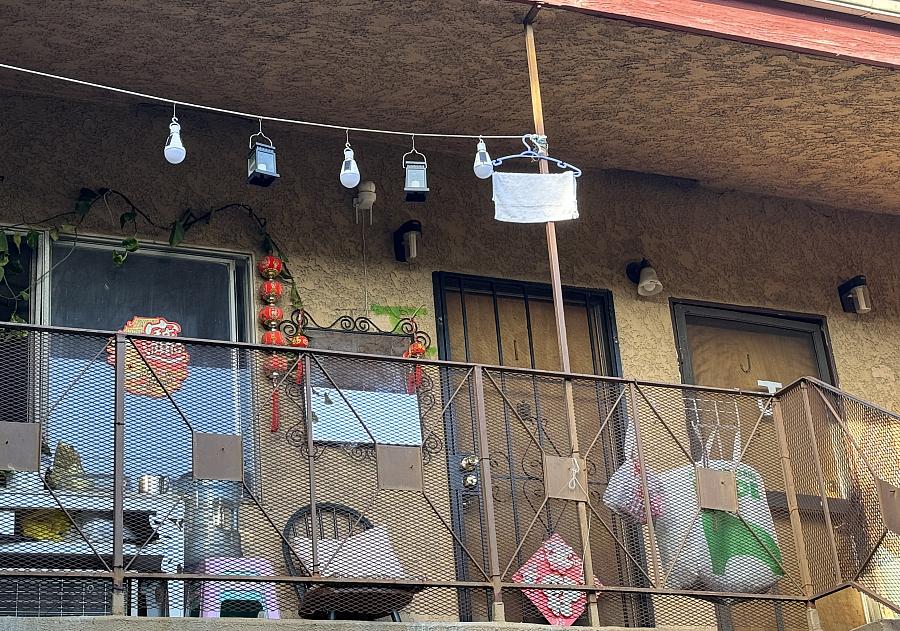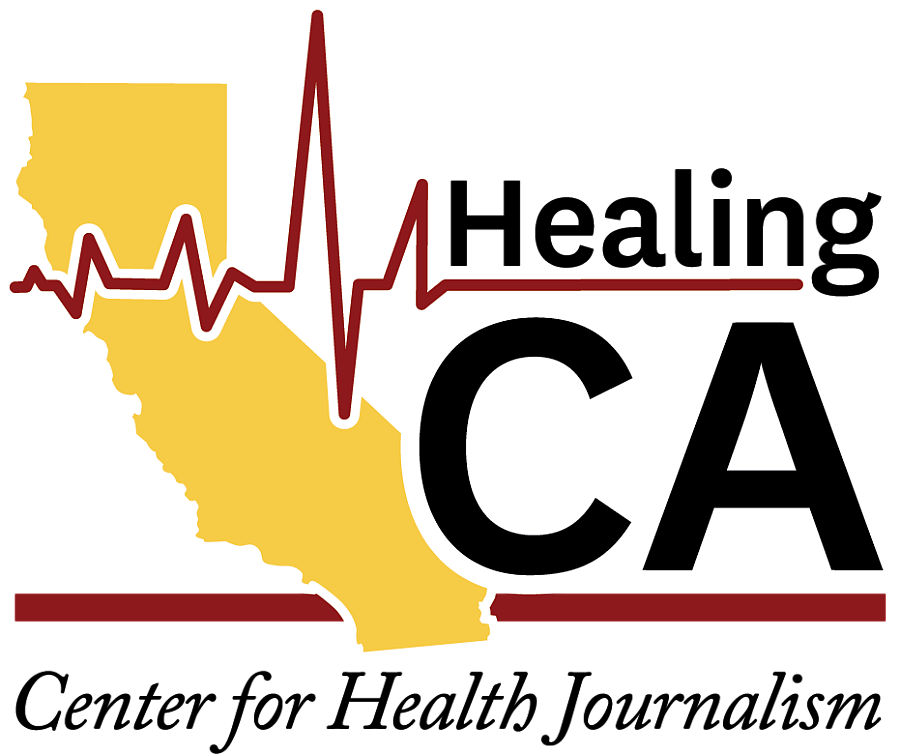Chinese Immigrants Squeeze into Cramped Housing in Los Angeles
The story was co-published with World Journal as part of the 2024 Ethnic Media Collaborative, Healing California.

The photo was presented at the city council meeting of Monterey Park on May 1, 2024.
Courtesy: City of Monterey Park
How many people can fit in a one-bed, one-bath apartment? In one two-story building in Monterey Park in Los Angeles County, the answer is 12.
At the city council meeting on May 1, 2024, Monterey Park Assistant City Attorney Timothy E. Campen showed several photos: In a small living room, there were nine makeshift beds crammed into a small living space. Another photo shows a crowded bathroom, with a washing machine placed on the bathtub.

The photo of a toilet being presented at the city council meeting of Monterey Park.
Courtesy: City of Monterey Park
The photos were taken at an apartment complex on a major avenue in Monterey Park. The two-story building houses 26 units. It’s a well-known boarding house for Chinese undocumented immigrants.
Across from this property is the area’s busiest square, bustling with people and vehicles. But the privacy of the building is ensured by a brick wall over two stories high. The only entrance has an iron door that requires an access code.
In the company of a resident who lives at the property, I walked into this “hotel" recently in an effort to understand how it operates, and what it tells us about the housing conditions many undocumented immigrants face as they strive to build new lives in this country. As I stood in the community's public area, I didn't sense much difference from any other low-income apartment building, except for the excessive clutter strewn in the hallways.
Inside the apartment, the living room and bedroom were filled with mattresses and sofa beds, with suitcases and personal belongings next to these beds. Since my visit took place during the day, the sofa beds in the living room area had been put away, giving it more of a living room appearance
At the entrance of each apartment, there was a locked box where tenants could put $15 to$18 in cash daily.

Clutter lines the building’s hallways.
Jian Zhao, World Journal
Investigation Into the “Hotels”
On August 8, 2022, a city inspection of the building found that at least 24 rooms had problems with overcrowding, with one rental unit having 12 beds. The 24 units housed a total of 232 beds, nearly 10 beds on average per unit.
In a systematic review conducted for World Health Organization’s (WHO), overcrowding is defined as a lack of space within a dwelling, and it can lead to adverse health outcomes, including tuberculosis (TB), infectious, gastrointestinal and diarrhoeal diseases. The review also mentions the negative impacts on mental health related to psychological stress, sleep disorders, and alcohol abuse and depression.
And in tightly packed accommodations in Los Angeles, with more than half a dozen people occupying living spaces intended for one or two, COVID-19 ran rampant in 2022.
City records indicate that this multi-family residential property is not zoned or licensed, for use as a hotel or for short-term rentals. Their violations include beds directly blocking the front doors, smoke detectors that don’t work, overloaded electrical receptacles, and what appears to be black mold in bathrooms. The overcrowding was so severe that a hole in the ground on the side of the building was being used as a toilet.
A recent Chinese immigrant named Kris had been staying in a similar "hotel" last year, a standalone house in Monterey Park, for $15 a night. He shared the bedroom with seven to eight people, with mattresses placed on the floor and no divider between beds.
"Tenants there change every week, and your sleep quality depends on your luck — some roommates snore, some talk nonsense during sleep, and some are very quiet ... At first, I couldn't sleep at all, felt anxious, and even got a lot of gray hair during that time."
Kris said such "hotels" help many newly arrived immigrants get through some of the most difficult times. Having a place to stay is important, since undocumented immigrants without a work permit and savings can’t typically afford a hotel or an apartment. Without this room-sharing option, they would have to sleep on the streets. In fact, some residents have been living here for years. They were either stuck in the immigration application process or completely rejected.
Although these "hotels" are off market, immigrants can easily find them through word of mouth, social media groups, and insider websites, said Kris.

After the city’s inspections and warnings, the makeshift beds are now replaced by sofa beds, making the room look like a regular living room during the day.
Jian Zhao/World Journal
Is There A Solution?
In September 2023, the city issued a public nuisance notice to the property owner. Early this year, a written notice issued to the property owner demanded payment of unpaid transient occupancy taxes for the past three years. As of May 1, the city had not yet received a response.
"Our legal department is dealing with it and have issued legislative subpoena," said City Councilor Yvonne Yiu. She said that allowing a large concentration of Chinese immigrants to live illegally within the same unit poses many potential dangers: evacuation danger, hygiene, fire, human rights, and many other issues. "On the other hand, we are also concerned that if they do not provide such accommodation, many people will become homeless,” Yiu added. “We have contacted relevant departments to pay attention to the people living in these places and hope to provide some relative services."
"Every problem has its corresponding solution, but the problem of reducing homelessness cannot be confused with legalizing these illegal family hotels," she said.
There Is Law to Follow, or Not
There are many such “hotels” operating in Monterey Park, whether they are apartments, standalone houses, or accessory dwelling units.
Lawyer Long David Liu, who has been working in the San Gabriel Valley for decades, stated that this type of housing has existed for at least 20 years. He says such buildings pose a dilemma for local government.
"Nobody likes to see over 10 people crammed into one room, but they are forced by circumstances, with no other choice. If the authorities crack down and shut down all these hotels, it will result in many people becoming homeless. Then, Monterey Park would become the second-largest homeless center in SoCal after Downtown LA.” Liu said.
Liu added that from a legal perspective, the local government has the discretion to not enforce the law. But the risks to tenants remain." But what if a fire breaks out?" asked Jose Ng, the immigrant rights program manager at the NGO Chinese for Affirmative Action, who pointed out that undocumented immigrants in the United States typically need six to seven months to obtain an Employment Authorization Document (EAD) card, also known as a work permit, before they can legally work. Before obtaining this document, they cannot afford regular rent. However, living in relatively inexpensive suburbs means losing out on job opportunities since they mostly engage in manual labor.

Across from the reported property is the well-known gathering place for undocumented immigrants called "Ding Pangzi Square". This is where undocumented immigrants begin their American lives, seeking employment opportunities and awaiting recruitment by contractors and restaurant owners.
Jian Zhao/World Journal
"On the other hand, these newly arrived immigrants lack legal documents and credit records, making it impossible for them to meet landlords' expectations for tenants. Finding a stable place to live is almost impossible for this group," Ng said.
Ng further noted that while some local governments provide temporary shelters, these resources are limited, and bed spaces are usually scarce. Chinese migrants often have language barriers, making it difficult for them to access these resources. According to his experience, existing temporary shelter resources are inadequate for Chinese immigrants as they lack tailored language and cultural support.
"This is not just a problem; it's a social phenomenon," Liu concluded.
Resources For the Undocumented
According to 2019 figures from the Migration Policy Institute (MPI), the estimated number of
undocumented immigrants in California is around 2.74 million, accounting for approximately 4% of the state's total population. Among them, there are approximately 390,000 Chinese undocumented immigrants in the United States, with over 110,000 residing in California. This figure does not include the surge of Chinese immigrants who crossed the U.S.-Mexico border after the pandemic, which is 50 times compared to two years ago.
Although lacking legal identity documents means being cut off from public resources, there are still some available. The major one is Medi-Cal. Starting from January 1, 2024, California has expanded public health care coverage by providing comprehensive coverage to low-income residents aged 26 to 49, regardless of immigration status. This policy means that undocumented immigrants in California can now obtain health insurance, which means not just physically secured, but also economically, giving them more flexibility on living expenses. Chinatown Service Center offers free service to assist new immigrants to apply for the Medi-Cal at its help centers in Los Angeles and Monterey Park.
Besides, in Southern California, Asian Americans Advancing Justice Southern California provide free legal aid covering immigration, housing, and discrimination in Chinese languages for undocumented individuals in the Los Angeles and Orange County area. While in the Northern part, Chinese for Affirmative Action holds events from time to time to offer legal assistance and shelter referral services for undocumented individuals in San Francisco.
There are also free immigration legal services for California community college students, staff and faculty. CSUs and UCs also have resources offered to undocumented students.

This project is supported by the USC Annenberg Center for Health Journalism, and is part of “Healing California,” a yearlong reporting Ethnic Media Collaborative venture with print, online and broadcast outlets across California.

